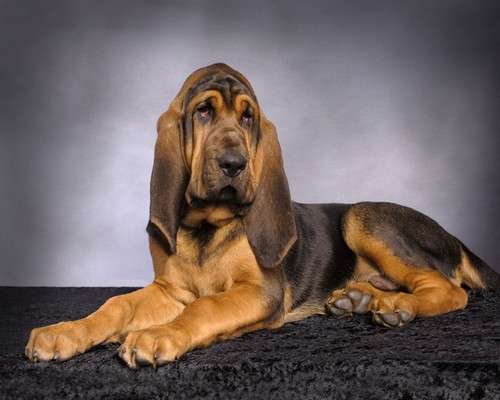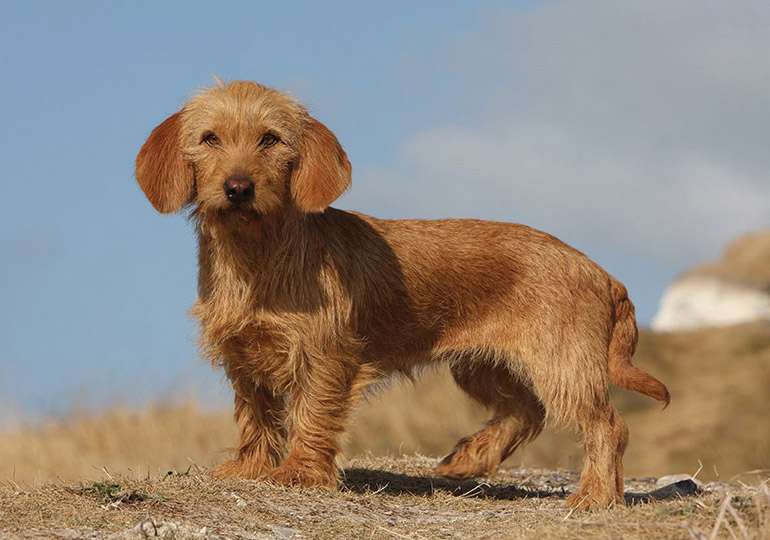
The bloodhound is a sizable scent hound that was developed first for deer and wild boar hunting as well as, starting in the Middle Ages, for human tracking.
Characteristics
This breed is renowned for its capacity to recognize the scent of humans across large distances and even days afterwards. It has an incredibly keen sense of smell and a keen, persistent tracking instinct. Weight ranges for bloodhounds are 36–72 kg. The majority of the weight of bloodhounds is concentrated in their thick, long bones, which have an extraordinarily massive skeletal structure. The coat of a scent hound is often firm and made entirely of fur, with no addition of hair.
Being a scent hound, the Bloodhound is low to the ground, has numerous flaps and wrinkles, and has long ears. The huge, thick lips and propensity to drool are features of many scent dogs. Scent hounds’ noses are quite sensitive, thus excessively fragrant shampoos and dips should be avoided unless absolutely necessary.

Care as Pet/ In captivity
The Bloodhound is a beloved breed among hound fans thanks to its sweet disposition and endearing, amusing demeanour. However, it takes a lot of time and effort from the owners of these high-maintenance pets for them to reach their full potential. It’s vital to conduct your homework and get ready for the correct care that these dogs require if you decide the Bloodhound is the right breed for you.
Exercise
Due to their high energy levels, bloodhounds need at least two hours of vigorous exercise every day. Running and hiking are excellent forms of exercise for owners of this breed. Although bloodhounds may run or walk for kilometers, they also like playing in the backyard.
Keeping these hounds on a leash or confined in a fenced-in yard is essential because they have a propensity to follow their noses and wander away during walks or plays. Your Bloodhound is the ideal participant in nose work games because the breed is renowned for having the best center of all. Hide and seek is a particularly enjoyable game that owners can play with these dogs to find either treats or family members.

Diet
You should feed your dog between 4 and 8 cups of premium dog food divided into two meals each day, depending on your dog’s age, size, and level of activity. To assist prevent Bloat, some Bloodhound owners choose to utilize slow-feeder bowls or give their dogs numerous smaller meals each. A bloodhound’s meals must contain a minimum of 18% protein and 5% healthy fats. Your Bloodhound will need to keep its muscles at this point. Large-breed dog chow of the highest caliber ought to be successful. A healthy diet should contain 12%–18% healthful fats and 20%–30% protein.
Grooming
Bloodhounds need routine grooming and washing because of the extensive, deep wrinkles that surround their faces, necks, and ears. Owners should plan on daily wrinkle cleaning. Cleaning them with a moist washcloth and carefully drying them can help stop the growth of bacterial infections. After every meal, make sure to brush the area around your mouth.
Each week, the Bloodhound’s droopy ears must be cleaned since they frequently collect dirt, debris, and bacteria. To get an ear cleaning solution, ask your veterinarian. Once a week, inject it into the ear canal and then gently massage the solution into the ear. Using a clean cotton pad or cloth, you can delicately remove any dirt, debris, or wax. Cotton swabs should not be used as they can harm the sensitive inner ear components.
The short, dense coats of bloodhounds should be brushed once a week with a rubber mitt or brush. Seasonal shedding may necessitate more brushing at this period. Because of their delicate, flimsy skin, owners must be cautious and gentle when grooming their pets. Like all breeds, your Bloodhound needs regular dental care, as well as periodic nail trimming.
Table





